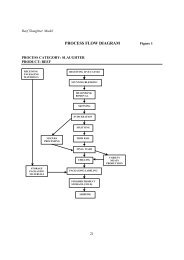Write down what went wrong and what you did about it in your diary.
Write down what went wrong and what you did about it in your diary.
Write down what went wrong and what you did about it in your diary.
You also want an ePaper? Increase the reach of your titles
YUMPU automatically turns print PDFs into web optimized ePapers that Google loves.
Safe method:Stock controlEffective stock control is an importantpart of manag<strong>in</strong>g food safety.What to doGo through <strong>you</strong>r menu <strong>and</strong>estimate how much of each<strong>in</strong>gredient <strong>you</strong> will need.Why?Work<strong>in</strong>g through the menuallows <strong>you</strong> to plan for <strong>you</strong>rspecific needs.How do <strong>you</strong> do this?• Review <strong>you</strong>r menu regularly <strong>and</strong> how<strong>it</strong> affects <strong>you</strong>r needs for stock.• Discuss <strong>you</strong>r needs w<strong>it</strong>h <strong>you</strong>r supplier.Plan ahead to make sure <strong>you</strong>have the right amount ofstock <strong>and</strong> order carefully.Check all stock when <strong>it</strong> isdelivered to make sure that:• <strong>it</strong> is w<strong>it</strong>h<strong>in</strong> <strong>it</strong>s ‘use by’ date• <strong>it</strong> has been kept coldenough• <strong>it</strong> has not gone off• the stock is clean <strong>and</strong> notdamaged, e.g. throw awayany punctured vacuumpacks, swollen packs orbadly dented cans <strong>and</strong>check that tops are secureon bottles <strong>and</strong> jars <strong>and</strong>seals are unbrokenCarry out regular stockchecks <strong>and</strong> throw away anyfood that has passed <strong>it</strong>s ‘useby’ date.Not hav<strong>in</strong>g too much stock isbest for food safety – <strong>and</strong> <strong>you</strong>rprof<strong>it</strong>s.These checks are all to makesure that food is safe for <strong>you</strong>to use.Damaged packag<strong>in</strong>g could meanthat food will not be safe touse.Swollen or ‘blown’ packs can bea sign that bacteria have grown<strong>in</strong> food or dr<strong>in</strong>ks.If bottles or jars have beenopened, or if seals have beenbroken, the food or dr<strong>in</strong>k mightnot be safe to use.You should never use food thathas passed <strong>it</strong>s ‘use by’ date,because <strong>it</strong> might not be safeto eat.• Plan the stock <strong>you</strong> need for each shift.• Make sure staff know the stock requirementsfor each shift.• Use a supplier who underst<strong>and</strong>s <strong>you</strong>rbus<strong>in</strong>ess needs <strong>and</strong> supplies stock on time.• Do a stock check before plac<strong>in</strong>g an order.• Tra<strong>in</strong> <strong>you</strong>r staff <strong>in</strong> <strong>what</strong> to look forwhen check<strong>in</strong>g deliveries.• Have a wr<strong>it</strong>ten agreement w<strong>it</strong>h <strong>you</strong>rsupplier <strong>about</strong> <strong>you</strong>r delivery requirements.• Carry out spot checks on thedeliveries <strong>you</strong>rself.• Use the <strong>diary</strong> to record any issuesor problems w<strong>it</strong>h deliveries.• If <strong>you</strong> move food from <strong>it</strong>s orig<strong>in</strong>alpackag<strong>in</strong>g to another conta<strong>in</strong>er, makesure <strong>you</strong> make a note of the name ofthe food, the <strong>in</strong>gredients <strong>and</strong> the ‘use by’or ‘best before’ date.• Follow the ‘first <strong>in</strong>, first out’ system ofstock rotation, so that older stock isused first. This helps to avoid waste.• Tra<strong>in</strong> <strong>you</strong>r staff <strong>in</strong> stock control <strong>and</strong> makesure they know <strong>in</strong> <strong>what</strong> order to use foods.• Check regularly that stock control is be<strong>in</strong>gcarried out effectively.• Record stock checks <strong>in</strong> the <strong>diary</strong>.What to do if th<strong>in</strong>gs go <strong>wrong</strong>• If <strong>you</strong> f<strong>in</strong>d that <strong>you</strong> have more food <strong>in</strong> stock than <strong>you</strong>need <strong>and</strong> <strong>you</strong> do not th<strong>in</strong>k <strong>you</strong> will use <strong>it</strong> all beforethe ‘use by’ date, <strong>you</strong> could freeze some of <strong>it</strong> to beused <strong>in</strong> the future.• If <strong>you</strong> f<strong>in</strong>d that food that has passed <strong>it</strong>s ‘use by’ date hasnot been thrown away, throw <strong>it</strong> away immediately.• If <strong>you</strong> do not th<strong>in</strong>k that a food delivery has been h<strong>and</strong>ledsafely, reject the delivery if possible. Do not use the food<strong>and</strong> contact <strong>you</strong>r supplier immediately.How to stop this happen<strong>in</strong>g aga<strong>in</strong>• Review <strong>you</strong>r order<strong>in</strong>g process.• Review <strong>you</strong>r stock rotation system.• Review <strong>you</strong>r agreement w<strong>it</strong>h <strong>you</strong>r supplier.• Tra<strong>in</strong> staff aga<strong>in</strong> on this safe method.• Improve staff supervision.MAN5/09-06











